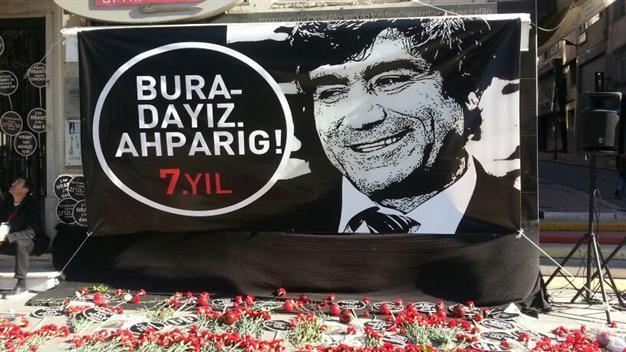Hrant Dink’s friends call for ‘justice’ on 7th year of murder
ISTANBUL

The crowd marched to the front of Armenian weekly Agos, where Hrant Dink was murdered in broad daylight by a 17-year-old ultranationalist in 2007. DHA Photo
Tens of thousands gathered in Istanbul to mark the seventh anniversary of the killing of Turkish-Armenian journalist Hrant Dink on Jan. 19.
The Friends of Hrant Dink organization, established in memory of the late journalist, called for a march starting at 1:30 p.m. from Taksim Square, which ended with a homage to Dink in front of the Agos newspaper’s office building in the Pangaltı neighborhood of Şişli.
Police took tight security measures around Istanbul’s Taksim Square and closed Gezi Park, which was the site of massive resistance against the government last summer, ahead of the commemoration.
The crowd marched to the front of Armenian weekly Agos, where Hrant Dink was murdered in broad daylight by a 17-year-old nationalist in 2007.
At 2:56 p.m., mourners observed a minute of silence for Dink, after which Gülten Kaya, the widow of late singer Ahmet Kaya, took the microphone. Kaya commemorated not only Dink, but also those who were killed during the Gezi Park Resistance last year. “We are here not only to remember Hrant, but also Ethem [Sarısülük], Abdullah [Cömert], Medeni [Yıldırım], Ahmet [Atakan] and those who died in the Gezi protests,” Kaya said. “You have left mothers and fathers devoid of their children. Sons of this country were shot with treacherous bullets. How can we forget how many homes were broken?” she said.
“What is your truth? This is 2014: You are carrying guns in your trucks instead of peace, democracy and human rights,” Kaya added, addressing Turkey’s security forces.
Dink, the highly esteemed former editor-in-chief of weekly Agos, was murdered in broad daylight in front of his newspaper’s building on Jan. 19, 2007ü by a 17-year-old Turkish nationalist. The triggerman, Ogün Samast, was convicted of premeditated murder and sentenced to 22 years and 10 months of prison after a two year-trial.
The marchers chanted the slogan “Buradayız Ahparig!” (a half-Turkish, half-Armenian slogan meaning “We are here, brother"), “For Hrant, for justice,” and “We are all Armenians,” in front of the Agos office. A popular chant from the Gezi Park protests, “Everywhere is Taksim, everywhere is resistance,” was also heard.
After the rally ended, the crowd marched to Taksim.
In a controversial apparent gesture, a number of traffic police officers assigned to the area were photographed wearing white caps. On the day of the murder, Samast was wearing a white cap, which later became an infamous symbol of the incident and a badge of pride among ultranationalist fascists.
Ertuğrul Günay, a former member of the ruling Justice and Development Party (AKP), asked Istanbul Gov. Hüseyin Avni Mutlu, who became the subject of mass revilement last year due to perceived lies surrounding the police's often brutal conduct during the Gezi Resistance, over Twitter who had ordered the police to don white caps.
A small group of Trabzonspor supporters also attracted attention, carrying a banner that read "We have not forgotten" in honor of the slain journalist; Samast and those involved in instigating the murder were based in Trabzon, and the Black Sea side's supporters are infamous for their ultranationalism. During the march, the Trabzonspor supporters chanted "Trabzonspor is here, where are the gangs?"
The Dink murder case remains unsolved, with the court ruling that it was not a result of an organized crime to the dismay of Dink’s family and supporters. The ruling was mde despite serious claims that a number of civil servants linked to the “deep state” were “indirectly” involved.
The acquittal of top suspects was ultimately overturned by the Supreme Court of Appeals and many key suspects charged as instigators of the murder, such as Yasin Hayal and Erhan Tuncel, are currently being retried.
The organizers of the commemorative march also denounced the trial process, accusing the state of protecting those responsible for the murder.
